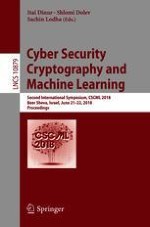2018 | OriginalPaper | Buchkapitel
Secure Non-interactive User Re-enrollment in Biometrics-Based Identification and Authentication Systems
verfasst von : Ivan De Oliveira Nunes, Karim Eldefrawy, Tancrède Lepoint
Erschienen in: Cyber Security Cryptography and Machine Learning
Aktivieren Sie unsere intelligente Suche, um passende Fachinhalte oder Patente zu finden.
Wählen Sie Textabschnitte aus um mit Künstlicher Intelligenz passenden Patente zu finden. powered by
Markieren Sie Textabschnitte, um KI-gestützt weitere passende Inhalte zu finden. powered by
Abstract
SNUSE, a secure computation based approach for non-interactive re-enrollment of a large number of users in BIA systems. We prototype SNUSE to illustrate its feasibility, and evaluate its performance and accuracy on two biometric modalities, fingerprints and iris scans. Our results show that thousands of users can be securely re-enrolled in seconds without affecting the accuracy of the system.